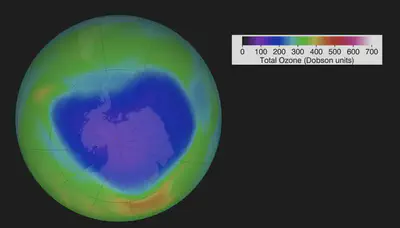Photonic Radiometers

Update September 2025
We are excited that our proposal Building critical capability for space-based climate monitoring with next generation photonics has been awarded $10,525,544 through the MBIE Endeavour Program – see more here
Background
The Antarctic ozone hole is close to New Zealand and has been remarkably large in six of the last nine years. It has significant impact on the environment through global weather patterns and our ability to forecast weather and future climates.
Current measurements
The current method of measuring the global ozone distribution uses a radiometer on a NASA satellite, the MLS on Aura. It detects the very faint (thermal) “glow” of climate gases in the microwave domain, uniquely allowing data acquisition at night-time and in the Antarctic polar winter when the annual Ozone hole forms.
This satellite burns up in 2026 and no follow-up has been funded due to the prohibitive costs of replacement missions.
 flies around the earth and has a sensitive detector pointed that picks up microwave radiation around 100-700 GHz. From the spectrum one can infer the distribution of various climate gasses, including ozone.](/projects/photonic-radiometers/Limb_hu87d8c300d8c22d7e500c609b18587a04_7362467_a21bf84639dd1a4d216e738ad11632b8.webp)
A new article accepted (March 2025) for the American Met Society Bulletin titled “The Imminent Data Desert: The Future of Stratospheric Monitoring in a Rapidly Changing World” (https://journals.ametsoc.org/view/journals/bams/aop/BAMS-D-23-0281.1/BAMS-D-23-0281.1.pdf) raises alarm on loss of MLS and the need for a new mission.
We were funded (2021-2024) through the MBIE Endeavour Space-ready radiometers for climate monitoring: using light to detect thermal radiation to work on this project together with Atmospheric Physicist A/Prof Annika Seppälä with an exciting group of further collaborators. With future funding we plan to get our results space borne!
Photonic Radiometer approach
We will develop and build a new class of radiometers that converts low-energy microwave radiation into the optical regime where detection is easier. Being cheaper, compact, energy-efficient, and less sensitive to noise, they will be able to be deployed on a low-cost CubeSat.
This is based on our previous idea of nonlinear frequency conversion. Whispering gallery mode resonators allow the tight confinement of both THz and optical radiation. With high quality confinement, the electro-magnetic field strength can get large enough that within a nonlinear material both wavelength can interact. We have proposed to use such a triple resonant system for sensitive detection of microwave and THz radiation Phys. Rev. A. (2009). We have furthermore shown theoretically and experimentally that the sensitivity can be so high that such systems could be used to detect the cosmic microwave background or be used for studying the temperature in the upper atmosphere Optica (2018).
We have recently demonstrated the nonlinear optical upconversion of multiple THz channels at frequencies of interest for atmospheric gas monitoring. Optics Express (2025)